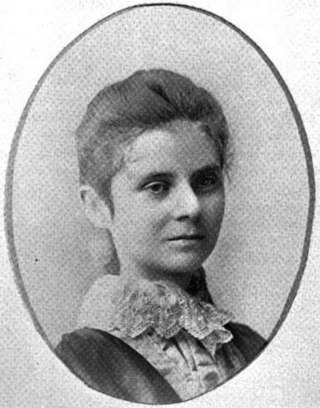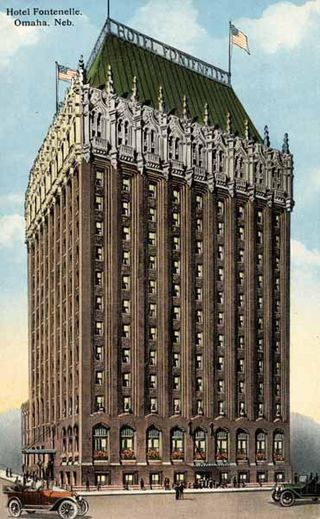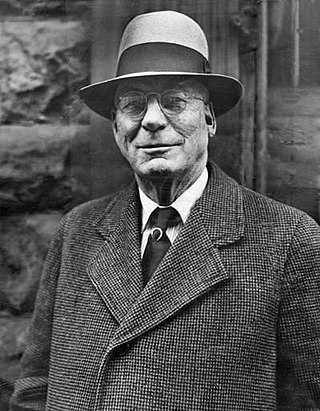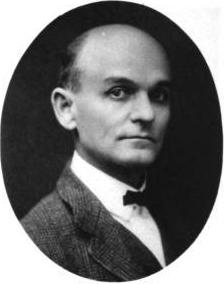In the broader context of racism in the United States, mass racial violence in the United States consists of ethnic conflicts and race riots, along with such events as:

The Omaha Race Riot occurred in Omaha, Nebraska, September 28–29, 1919. The race riot resulted in the lynching of Will Brown, a black civilian; the death of two white rioters; the injuries of many Omaha Police Department officers and civilians, including the attempted hanging of Mayor Edward Parsons Smith; and a public rampage by thousands of white rioters who set fire to the Douglas County Courthouse in downtown Omaha. It followed more than 20 race riots that occurred in major industrial cities and certain rural areas of the United States during the Red Summer of 1919.

Elia Wilkinson Peattie was an American author, journalist and critic.
Roy Belton was a 19-year-old white man arrested in Tulsa, Oklahoma with a female accomplice for the August 21, 1920 hijacking and shooting of a white man, local taxi driver Homer Nida. He was taken from the county jail by a group of armed men, after a confrontation with the sheriff, and taken to an isolated area where he was lynched.
The civil rights movement in Omaha, Nebraska, has roots that extend back until at least 1912. With a history of racial tension that starts before the founding of the city, Omaha has been the home of numerous overt efforts related to securing civil rights for African Americans since at least the 1870s.

The history of Omaha, Nebraska, began before the settlement of the city, with speculators from neighboring Council Bluffs, Iowa staking land across the Missouri River illegally as early as the 1840s. When it was legal to claim land in Indian Country, William D. Brown was operating the Lone Tree Ferry to bring settlers from Council Bluffs to Omaha. A treaty with the Omaha Tribe allowed the creation of the Nebraska Territory, and Omaha City was founded on July 4, 1854. With early settlement came claim jumpers and squatters, and the formation of a vigilante law group called the Omaha Claim Club, which was one of many claim clubs across the Midwest. During this period many of the city's founding fathers received lots in Scriptown, which was made possible by the actions of the Omaha Claim Club. The club's violent actions were challenged successfully in a case ultimately decided by the U.S. Supreme Court, Baker v. Morton, which led to the end of the organization.
Racial tension in Omaha, Nebraska occurred mostly because of the city's volatile mixture of high numbers of new immigrants from southern and eastern Europe and African-American migrants from the Deep South. While racial discrimination existed at several levels, the violent outbreaks were within working classes. Irish Americans, the largest and earliest immigrant group in the 19th century, established the first neighborhoods in South Omaha. All were attracted by new industrial jobs, and most were from rural areas. There was competition among ethnic Irish, newer European immigrants, and African-American migrants from the South, for industrial jobs and housing. They all had difficulty adjusting to industrial demands, which were unmitigated by organized labor in the early years. Some of the early labor organizing resulted in increasing tensions between groups, as later arrivals to the city were used as strikebreakers. In Omaha as in other major cities, racial tension has erupted at times of social and economic strife, often taking the form of mob violence as different groups tried to assert power. Much of the early violence came out of labor struggles in early 20th century industries: between working class ethnic whites and immigrants, and blacks of the Great Migration. Meatpacking companies had used the latter for strikebreakers in 1917 as workers were trying to organize. As veterans returned from World War I, both groups competed for jobs. By the late 1930s, however, interracial teams worked together to organize the meatpacking industry under the United Packinghouse Workers of America (UPWA). Unlike the AFL and some other industrial unions in the CIO, UPWA was progressive. It used its power to help end segregation in restaurants and stores in Omaha, and supported the civil rights movement in the 1960s. Women labor organizers such as Tillie Olsen and Rowena Moore were active in the meatpacking industry in the 1930s and 1940s, respectively.

Tom Dennison, known as Pickhandle or Old Grey Wolf, was an American political boss and racketeer in Omaha, Nebraska. A politically savvy, culturally astute gambler, Dennison was in charge of the city's wide crime rings, including prostitution, gambling and bootlegging in the 1920s. Dennison is credited with electing "Cowboy" James Dahlman mayor of Omaha eight times, and when losing an election, inciting the Omaha Race Riot of 1919 in retribution against the candidate who won.
African Americans in Omaha, Nebraska are central to the development and growth of the 43rd largest city in the United States. Black people are first recorded arriving in the area that became the city when York came through in 1804 with the Lewis and Clark expedition and the residence of Jean Baptiste Point du Sable who lived at Fort Lisa for an extended period in 1810. There were also enslaved Black people at the Church of Latter Day Saints Winter Quarters in 1846. The first free Black settler in the city arrived in 1854, the year the city was incorporated.
Crime in Omaha, Nebraska has varied widely, ranging from Omaha's early years as a frontier town with typically widespread gambling and prostitution, to civic expectation of higher standards as the city grew, and contemporary concerns about violent crimes related to gangs and dysfunctions of persistent unemployment, poverty and lack of education among some residents.

James Charles Dahlman, also known as Jim Dahlman, Cowboy Jim and Mayor Jim, was elected to eight terms as mayor of Omaha, Nebraska, serving the city for 20 years over a 23-year-period. A German-American and an agnostic, Dahlman grew up in a ranching area and started working as a Texas cowboy. He was elected as a county sheriff and small town mayor in western Nebraska before moving to Omaha.

The present Douglas County Courthouse is located at 1701 Farnam Street in Omaha, Nebraska, United States. Built in 1912, it was added to the National Register of Historic Places in 1979. Notable events at the courthouse include two lynchings and the city's first sit-in during the Civil Rights Movement. Five years after it was opened, the building was almost destroyed by mob violence in the Omaha Race Riot of 1919.
Various ethnic groups in Omaha, Nebraska have lived in the city since its organization by Anglo-Americans in 1854. Native Americans of various nations lived in the Omaha territory for centuries before European arrival, and some stayed in the area. The city was founded by white Anglo-Saxon Protestants from neighboring Council Bluffs, Iowa. However, since the first settlement, substantial immigration from all of Europe, migration by African Americans from the Deep South and various ethnic groups from the Eastern United States, and new waves of more recent immigrants from Mexico and Africa have added layers of complexity to the workforce, culture, religious and social fabric of the city.
Significant events in the history of Omaha, Nebraska, include social, political, cultural, and economic activities.

In Forsyth County, Georgia, in September 1912, two separate alleged attacks on white women in the Cumming area resulted in black men being accused as suspects. First, a white woman reportedly awoke to find a black man in her bedroom; then days later, a white teenage girl was beaten and raped, later dying of her injuries.
Claude Neal was a 23-year-old African-American farmhand who was arrested in Jackson County, Florida, on October 19, 1934, for allegedly raping and killing Lola Cannady, a 19-year-old white woman missing since the preceding night. Circumstantial evidence was collected against him, but nothing directly linked him to the crime. When the news got out about his arrest, white lynch mobs began to form. In order to keep Neal safe, County Sheriff Flake Chambliss moved him between multiple jails, including the county jail at Brewton, Alabama, 100 miles (160 km) away. But a lynch mob of about 100 white men from Jackson County heard where he was, and brought him back to Jackson County.

The Perry massacre was a racially motivated conflict in Perry, Florida, in December 1922. Whites killed four black men, including Charles Wright, who was lynched by being burned at the stake, and they also destroyed several buildings in the black community of Perry after the murder of Ruby Hendry, a white female schoolteacher.

The Newberry Six lynchings took place in Newberry, Alachua County, Florida, on August 18, 1916.

On October 11, 1878, Jim Good, Jeff Hopkins, Ed Warner, William Chambers, and Dan Harris, Sr. were lynched in Posey County, Indiana, near the town of Mount Vernon. These men, who were allegedly connected to the robbery of a brothel, were killed by a white mob who broke into the jail where they were being held. Two other men, Dan Harris, Jr. and John Harris, were also lynched in the days leading up to October 11, in connection with the same alleged offense. This racial terror lynching is the largest reported lynching in Indiana's history.









